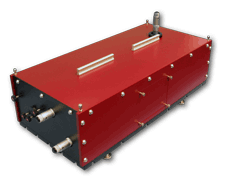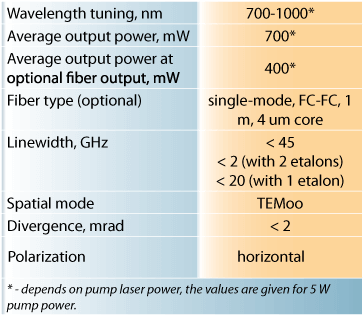TiC Continuous-Wave Solid-State Ti:S Tunable Laser System
Automated tuning range of 700 to 1000 nm
Output average power >1.5 W (@8 W pump, 800 nm)
Linewidth down to <2 GHz
2 to 10 W pump laser integration option
Optional routing systems for microscope coupling

1. General
The TiC CW tunable laser is the choice with applications where tuning range and high average power level are a must, such as spectroscopy, semiconductor research and many more. The laser system features titanium-sapphire active medium for obtaining broad tuning range of 700 to 1000 nm with linewidth of <45 GHz. The system is equipped with a birefringent Lyot filter for manual or USB-controlled wavelength tuning*. A spectrometer unit can be also integrated into the system for fully automated tuning process. Optional thick and thin automated etalons can be installed into the resonator cavity to bring the linewidth down to <2 GHz. Windows PC software is provided with the laser system for easier tuning and calibration.
The output power depends on the pump laser used with the system. If you do not have a suitable pump laser (DPSS 532 nm, CW, TEM00, low noise), consider the TiC-F – integrated pump laser option with average pump powers from 2 to 10 W (TiC-F2 to TiC-F10) to make your Ti:S oscillator system complete.
The TiC-F2 featuring the AT-532-2 built-in CW DPSS pump laser with 2 W average power may be used as the most budget-friendly solution to set up an operational Ti:S CW laser. A pump laser may also be installed externally or sold separately.
We also would be glad to provide routing systems for your microscope setup, just send us your dimensions and microscope details (mainly beam input height).
* – see Modifications tab to select wavelength tuning options.
2. Specifications

3. Modifications
-ML – manual Lyot filter with micrometer screw wavelength control
-UL – USB-controlled Lyot filter with software for wavelength control (default)
-NL – no Lyot filter installed, single wavelength and broader linewidth.
-Fxx – integrated pump laser option with average pump powers from 2 to 10 W (TiC-F2 to TiC-F10) to make
your Ti:S oscillator system complete.
-1E – 1 USB motorized etalon for narrow linewidth of <20 GHz.
-2E – 2 USB motorized etalons for linewidth of <2 GHz.
-SP – built-in spectrometer (necessary for fully automated tuning).
-PW – adds a built-in power meter for average power monitoring via USB.
-TS – thermostabilized breadboard for improved stability in volatile environmental conditions.
-CH – re-circulating chiller option
-PR – the TiC laser requires horizontally polarized pump. If you already own a vertically polarized pump,
you can rotate its pol by using our optional pol rotator.
4. Applications
Spectroscopy
Semiconductor research
Raman spectroscopy
5. FAQ
Q.Do I need a chiller for proper laser operation?
A. Tap water supply may be used to stabilize the system, but in this case we cannot guarantee the quoted stability. We recommend purchasing the –CH chiller option (see below) or using an existing lab chiller. The 2 and 3 W systems may operate without any water circulation at all, but again with no stability guarantee. Under room temperature the systems do not produce much heat to dissipate; the chiller is mainly required for stabilization purposes. If the laser and the chiller are operated around room temperature, then <60 W heat dissipation capacity is required from the chiller unit.
Two connection tubes are provided with the laser.
Q.What is the –TS option for and what are volatile lab conditions?
A. The –TS option is a thermostabilized breadboard that is connected to a chiller (option -CH) to stabilize the whole laser system. Such stabilization might be necessary if the environmental conditions of the lab are quite volatile. Under such conditions we mean no aircon or temperature changes over ±2° during the 8-hour period, air flow right over the optical surface, poor vibration protection, substantial amounts of dust.
6. RFQ Hints
Just some quick hints before you send us an RFQ:
1. If you do not need wavelength tuning and narrow linewidth, we can offer systems without the Lyot filter.
2. The Lyot filter can be either manually controlled via a micrometer screw, or motorized with a step motor for USB control. See Modifications for details.
3. Decide on whether you require a pump laser together with the system and select the pump power. Remember that Ti:S output average power greatly depends on the pump level. See tuning curves for details.
4. Equip your system with modifications if necessary. See the Modifications tab.